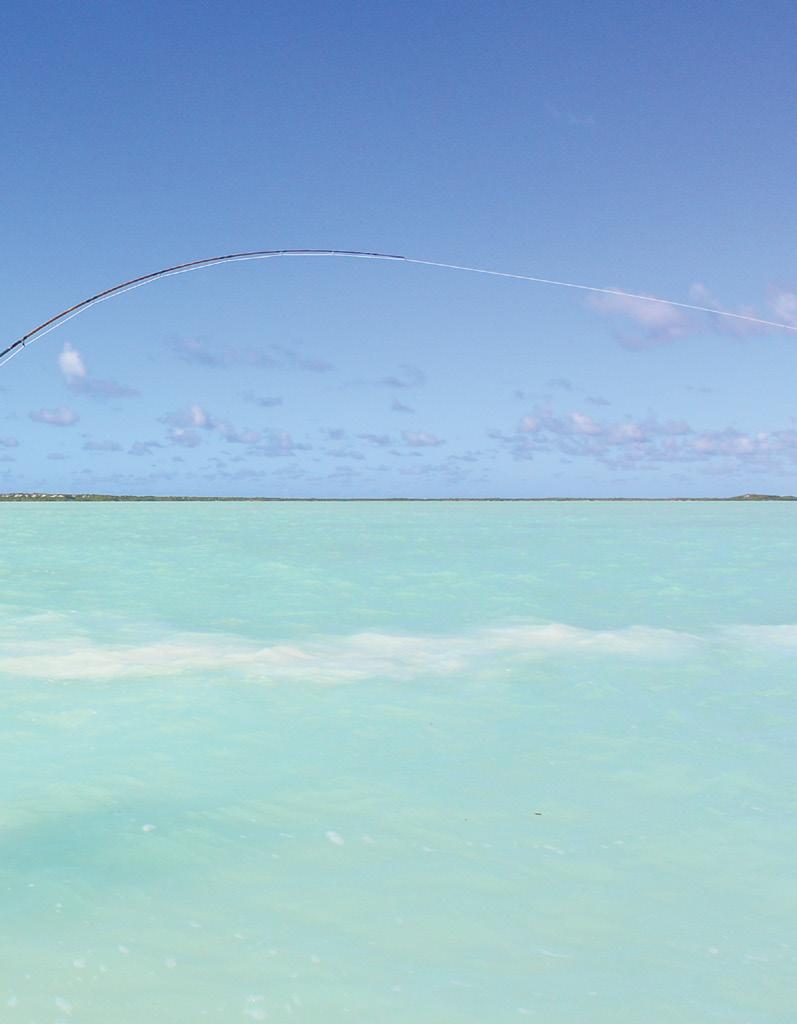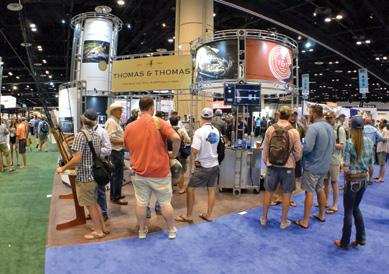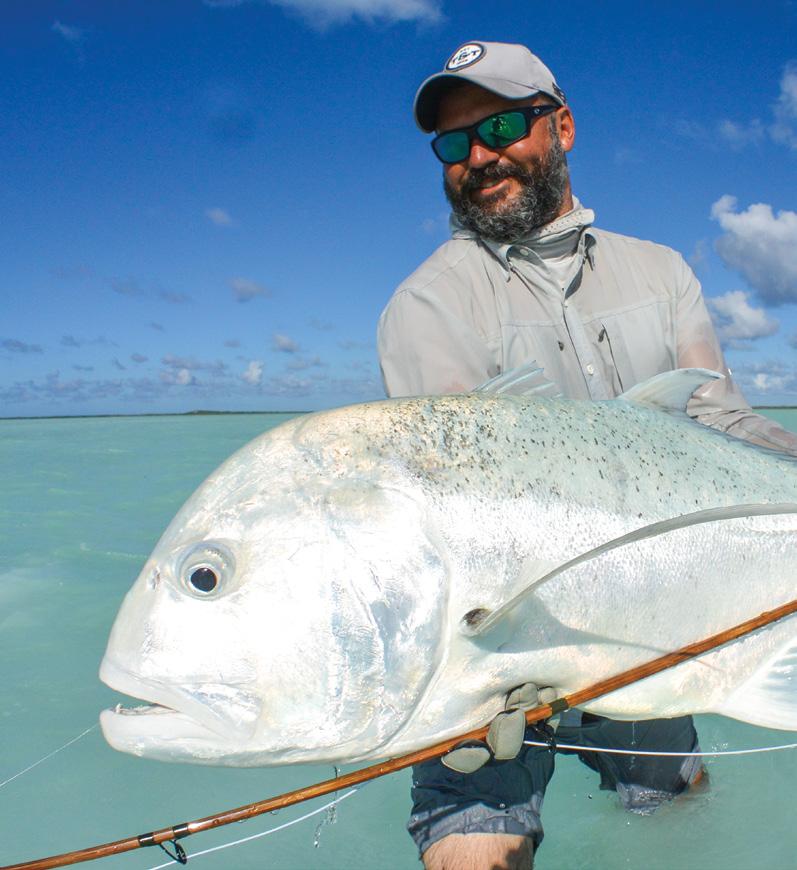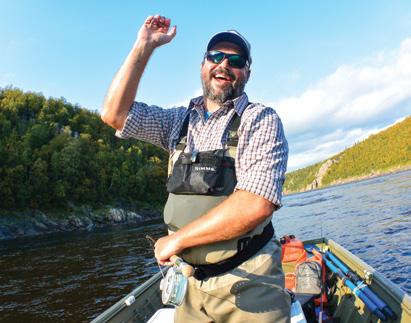
18 minute read
SLAMBOO
BACK TO THE FUTURE SLAMBOO
THE WORLD’S STRONGEST AND MOST SOUGHT-AFTER FRESH AND SALTWATER FISH ON A BAMBOO FLY ROD? IT SOUNDS LIKE THE KIND OF THING YOUR GRANDPA DREAMED OF 100 YEARS AGO, BUT FOR NICK BOWLES IT WAS A MODERN CHALLENGE BASED ON HISTORY. ARMED WITH THOMAS & THOMAS’S MODERN SEXTANT BAMBOO RODS AND THE MEMORY OF HIS GRANDFATHER, HE SET OFF TO ATTEMPT AN UNLIKELY GRAND SLAM.

Photos Nick Bowles, Alphonse Fishing co
Sitting on top of a sand dune in front of Beach Bungalow number 3 on Cosmoledo, Seychelles overlooking the bay of Wizard Island with the sun rising up from behind me, it is hard not to think about who you are, what you are doing and where you have come from. My mind drifts to my connection to the sea, to fly fishing and how I got to be sitting on this sand dune trying to catch big GTs on bamboo fly rods.
BLOOD LINES
My story begins with my paternal grandfather, Kenneth Fox (aka Kulu), and my grandmother, Bessie Fox (aka GorGor). They farmed in Yorkshire, UK and my grandfather was a true English gentleman. Shooting, fox hunting and salmon fishing were his pursuits. He used to fish for salmon in Norway, Iceland and the River Spey in Scotland, all very traditional and old school. He was part of a syndicate in the early ‘70s that took over the fishing and shooting on the Talchin Estate on the River Spey and one of the conditions, with the owner the Countess of Seafelt for taking over the fishing and hunting was that my grandfather had to farm the lands. My biological father, Nigel Fox, was to be the farm manager. My mother, Bibbi Bowles, is Norwegian and met my father in Aviemore, a nearby ski resort. On their first date Nigel picked my mother up on a tractor from the farm, they got married and so I came to be! To cut a long story short, the marriage didn’t work out and my paternal grandparents, wanting to keep their grandson close, managed to convince my mother to move with them to South Africa. In the late ‘70s my mother married Derek Bowles, who adopted me. I grew up on a sugar cane farm in Umfolozi, Zululand and it was a kid’s wildest dream: fishing, shooting, hot weather, every animal, snake and bug imaginable! My dad, Derek, fished as part of the South African Deep Sea team in the ‘70s and fished around the world chasing marlin and big tuna: Hawaii, Mauritius, Nova Scotia, Australia. In the early ‘70s Derek’s own father caught an 885lbs marlin in Pomene, Mozambique from a 16ft ski boat. So, one way or another, I was always going to fish. But where and how I learnt to fish, was from our camp at the Mapelane Skiboat club, off ski boats in saltwater, with warm weather, mosquitoes and white beaches. There we caught couta, kingfish, snoek, sailfish, etc. Living in Umfolozi, a fairly remote area, schooling was a problem so I was sent to boarding school in Pietermaritzburg from about the age of nine. Kulu and Gor-Gor had moved to Hilton so most weekends I would visit them. Kulu had stocked a dam with trout and had bought a Winchester 410 to shoot the cormorants that ate them. This is where I learnt to fly fish. Kulu had two bamboo trout rods named Noddy and Big Ears. He would stand in his safari suits (tweeds were too warm) and wading boots on the banks of the lake or the surrounding rivers and I would be barefoot in my shorts and school T-shirt, as he tried to teach me fly fishing etiquette. All I wanted was to catch fish, shoot cormorants and throw rocks into the lake. I can only imagine how I tested his patience, but he kept showing me how to cast a fly, how to tie on flies, how to make leaders without ever raising his voice. I guess his passion and dedication towards me and fly fishing soon prevailed and I learnt to cast out a fairly decent line on Noddy and started to catch rainbow trout. I think this was the start of a long, on-going journey.

Nick’s grandfathers Kenneth Fox, aka Kulu in his salmon fishing days




PAYDIRT IN DUBAI
In 2001, when Michelle (now my wife), told me she was moving to Dubai from London, I had to consult Google to find out where it was! Then I typed in “Fishing Dubai” and my heart skipped ten beats. Sailfish! It was a no brainer and it wasn’t long before I left my cold office in Bank Street for a four month holiday in Dubai. Twenty years later I am still here, so I consider myself still “on holiday”. Dubai presented me with a whole bunch of opportunities to fish and to travel and in 2003 I started a small brand and website called Ocean Active. Initially, this was only intended as a hobby because there was limited information on fishing in Dubai. Soon charter requests started coming in and Ocean Active (the company) was born in early 2005. The desire to explore and camp like I had done in South Africa grew strong, and we turned our attention to Oman, a wonderful, friendly country with wide open beaches and an amazing amount of sea life. We found incredible fishing and our Oman operation was the first fly fishing and topwater operation in Oman and the Middle East. We were young and had little idea of what we were doing, but we loved it and the business grew organically while we learnt. As the company and bookings grew, we started running more trips so we needed more equipment and, with no fly shops for thousands of miles, I started to contact fly tackle manufacturers in the US. But, without knowing someone personally or meeting face to face, it is quite difficult to build a relationship. I had to explain that I was not crazy and yes, we were fly fishing in Dubai, Oman and the Middle East and yes, we were catching GTs, permit, sails, bream, queenfish, golden trevally and loads of other species.

FIRST SIGHTING
I decided that the only way to build new relationships with manufacturers was to attend exhibitions like iCast, IFTD, Efftex in USA and Europe. Not knowing anyone, I packed my bag, booked my tickets and started going to shows, arranging meetings, trying to meet people that I had only seen in magazines or TV shows. I met a few people, showed a few pictures and quite quickly realised that the fly fishing community was filled with amazing, open people who were happy to meet, give advice, and make introductions. I soon met a large, varied bunch of people who, to this day, are some of my closest friends. Word started getting around about Dubai and Oman and our fishery was launched internationally. I met the Alphonse and T&T crew over a beer at the Simms booth. Chatting to Keith Rose Innes, Devan van der Merwe, Llew Claven of Alphonse and Neville Orsmond and Troy Jacques of Thomas & Thomas (T&T), it soon became evident that many more beers and stories would be shared in the future. It was at this show that I first noticed that T&T made handmade bamboo rods. Then they were just something I looked at and admired for their amazing workmanship, like a piece of art. I had no inclination to buy or use one. Who the hell uses bamboo rods, let alone in the salt?
A LIGHTBULB MOMENT
The following year, before IFTD, we headed with the Alphonse and T&T crews to Apalachicola, Florida. While doing some tackle set up, Keith pulled out a Sextant 12-weight bamboo rod. I couldn’t believe what I was seeing. Obviously, trying to play it cool, I walked over, had a look and walked away. The fire was ignited. I wanted to cast that rod! The next day, as only Keith can do, he went out and landed a 120lbs tarpon on the bamboo and the fish never once got into the backing. I was hooked. I immediately thought of my childhood, learning to fly fish with my grandfather. Could I really catch saltwater fish on bamboo? At the IFTD show on the same trip, T&T had a tent at the casting pond, and they had bamboo rods on display. I finally picked up the Sextant 10-weight like it was made of porcelain and walked up to the pond and put out my first cast. The cast was slow, the rod was heavy but gracious and the cast almost went across the pond. Okay, it was a small pond, but the rod in my hand felt like a 1000 volts. Something clicked, something forgotten. I didn’t realise what it was, but it felt so good. I put down the rod at the end of the session and said my farewells.
Not long after that, while on a family pilgrimage with my mother and sister to my mother’s family home in Nordaal, Norway, my mind was still on that bamboo rod. Could I catch fish on it in the salt? I left the family in Nordaal and headed for Osen to fish for Atlantic salmon for the first time. I left the family in Nordaal and, on the recommendation of Jako Lucas, headed for Osen to fish for Atlantic salmon for the first time. There I met a South African, Mark Taylor who was running Osen Gard Salmon Lodge. Mark and another South African, James Topham, showed me how to cast a doublehand and to swing flies for salmon. While wading in the river on my own, in awe of the sound of the rapids, the snow-capped mountain and forest of green, I experienced a sudden flood of emotion. It was the memory of my grandfather teaching me to fly fish on bamboo, the thought of him having once stood in a similar river in Norway fishing for salmon. It was then that I decided I was going to buy a Sextant bamboo 10-weight rod and catch big saltwater fish. It was a mission that felt like it would connect me with my grandfather. Back in Dubai, still buzzing with excitement, I spoke to Trevor Skinner, my partner in Ocean Active Fly, and my fishing buddy. Being the gentleman he is, he agreed he would also buy a Sextant 10# and help me on my mission. I called up Neville Orsmond and Thomas & Thomas’s master bamboo craftsman Troy Jacques and we planned our first bamboo rods. Fittingly I named my rod after my Grandfather “Kulu”.
A few, long months passed and the rods finally arrived. Trevor and I took them out of the tubes and then out of the sleeves as if they were pure gold. They were masterpieces. During the time it took for the rods to be built, we had planned the trips for the season. First up was a trip to Astove, Seychelles, then a trip back to IFTD and fishing in the Keys and lastly, to round off the year, we would be fishing Ponoi, Russia. The scene had been set; the opportunity was there to do something that I could not imagine in my wildest dreams. We were going to be fishing with bamboo in some of the most respected and recognised fly destinations on the planet to catch three iconic fish species … GT, tarpon and Atlantic salmon all on bamboo in one season. This challenge later got named the Slamboo.





SLAMBOO - CHAPTER 1
For the first trip to Astove we packed all the rods into a big rod tube as the bamboo was a two piece. So, logistically and weightwise, it was already a setback. But we repacked and repacked until I basically had one set of clothes, fishing gear, camera, toothbrush and a bottle of whiskey. We flew into Astove and were met by the Alphonse team, Kyle Reed, Stu Webb and Alec Gerbec. These guys were our good friends but, when we pulled out the bamboo, there were some uncertain looks. The first afternoon Trev and I walked down the bay in front of the lodge to wet a line. I had my 12# Exocett GT rod and the 10# Sextant bamboo, but I couldn’t bring myself to take the bamboo into the salt water wading! It was too perfect and I was worried I would break it. On about the third day (and most probably after finishing the bottle of whiskey), I decided I was going to fish the bamboo. We walked on the low tide to the seaward edge of the lagoon mouth and came back with the tide, catching bonefish, shots at triggers and emperors. It was great fun and we realised quite quickly that the Sextant is most probably tougher and hardier than my carbon fiber rods. It’s made out of a natural, extremely strong material. After all, people build buildings out of bamboo and I’ve never seen a carbon fiber house. These rods are strong. Plus, your chances of being hit by lightning are vastly reduced. As my confidence in the rod grew, so did my bravery to cast a bigger fish. Fishing with Kyle Reed in the lagoon in milky water, he had warned me that we were looking mainly for permit but could run into a GT at close quarters, sort of hand-to-hand combat style. With the Sextant 10# rigged with 20lbs fluoro and an Aphlexo Crab, we drifted slowly through the milky waters. Suddenly Kyle called out “Shadow 9 o’clock 15ft short!” I turned and saw a faint shadow moving! Dropped a short cast, straightened the line and we saw a big puff of white. Kyle was shouting, “He’s eaten it, SET”. I set and an almighty explosion happened next to the boat! Next thing Kyle shouted, “GGGGGGGGTTTTTTTTTT”. The fish must have got as much of a fright as I did and it took off, rooster tailing across the shallow flats with Kyle in hot pursuit. I jumped off the boat and could only stand and watch the line melt off the reel, but loving every second. The bamboo bent deep into the butt section and handled all the pressure like a suspension spring! The fish slowed and, because of the shallow water and with each kick of the tail you could see the white water thrashing. With every change of direction the back came out of the water. I was weak at my knees as Kyle finally tailed the fish. There was a huge celebration and another wave of emotion. Yes, to catch big saltwater fish on bamboo was possible! There were a few pictures; a swig out of my grandfather’s flask; a few moments of silence for the fish, the rod and my grandfather and the fish was released. The feeling of contentment and calm was real.

SLAMBOO - CHAPTER 2
First part of the mission ticked, there was a slight glimmer of hope that the Slamboo was possible. A couple of months later we attended the IFTD show and after the show it was time for the second part of the mission … target tarpon. We drove down the Keys and, having never been there before, there was a sense of anticipation and expectation from an area that was probably the birth place of modern fly fishing in the salt. Many incredible anglers had fished these waters so it was quite fitting that the second part of our mission to catch a big saltwater species, was in the Keys. We rigged up and the Sextant 10# was rigged, tarpon fly attached. First day on bamboo we had some shots at smaller tarpon and landed a few nice bonefish plus had a shot at a huge permit. The excitement mounted. This could happen. On the second day big, bad Llew Claven and I fished with Gabe Nyblad on the pole. We headed out one of the mouths, Big Pine Key, and were greeted by the amazing sight of rolling tarpon everywhere on a shrimp hatch. Before the trip the guides had told us that, because we were there in July, it was the tail end of the tarpon season so we would have to fish hard for them. But this was like winning the Lotto! Gabe set up a drift through the seagrass and rolling tarpon and we just drifted through, casting at rolling fish all day long. We had several eats and jumped a few fish but I desperately wanted the fish on for the fight on the bamboo and to land the fish to complete mission tarpon. There were fish from 20lbs up to 150lbs, so it was a total lucky packet. Finally I saw a decent fish roll within range. I put in the cast, waited, short strips, tap tap tap, booooooooommmmm… an almighty eat in dirty water. The fish gave us a great side view and I set the hook. Tarpon on. The fish took off making several jumps, peeling line off, Sextant bent deep into the butt again but taking all the pressure. Slowly the fish tired and I managed to get the line over his back and rolled him a couple of times. Then Gabe lipped the fish. Relief, joy, emotion all came flooding back. I had landed a tarpon on the bamboo! Very happy and proud, I had a few sips out of grandfather’s old flask; we took a few pictures; I said my thanks to the fish, the rod and remembered my grandfather and released the fish. It felt surreal. The trip ended with several more tarpon on the bamboo and, the second mission accomplished, I was two thirds through the Slamboo.
SLAMBOO - CHAPTER 3
Back in Dubai we regrouped and started to get ready for Ponoi, Russia. This was a whole different ball game. This was freshwater, Russia and a place I had never visited but, with all of the stories I’d heard and read, I was excited to fish this legendary river. Packing all the warm clothes I possessed, we boarded the flight from Dubai to London; London to Helsinki; Helsinki to Murmansk; Murmansk by helicopter to Ryagaba Camp, Ponoi. What an incredible place. You could feel the energy and history of this great fishery. We set up tackle, all double handers and then out came the Sextant bamboo. Andrei Fedorov was our guide helping with the set up and he asked one simple question, “Vhy bamboo?” I just shrugged as I was not sure how to answer.
After a great first evening and having tried to stay up to see the Northern Lights and, most probably having had too much vodka, the next day we boarded our boats with Alex Sokolov as our guide. We had the beat above the home pool. This was very different to fishing in Norway, casting out from the boat and swinging the flies across the river. With the Sextant single hander this suited me well. About 30 minutes after we started fishing I felt a faint tug. Fighting the urge to strip strike the fish, I slowly lifted the rod and felt the pressure of the fish, pulled a bit more and it woke up and took off on a run across the river with a single jump, and my heart skipped a beat. This was really going to happen. Playing the fish with soft hands, like a person does when they really don’t want to lose the fish, but fighting it like that would be the worst thing, the fish finally came to the boat and was netted. Joy, relief, amazement were all felt at the same time. What started out as a pipe dream, had been accomplished. What started out as something that I didn’t think possible, had happened. Once again, I had a few swigs out of grandfather’s old flask; we took a few photos with the fish; let it go; sat back; said a little thank you to my grandfather for having had the patience to teach me on the side of that lake so many years ago. I don’t know if it’s a sense of belonging, heritage or just human nature wanting to have a reason to do something, but I felt the circle had come 360. So, as I sit on top of my sand dune in Cosmo, thinking about what this all means, I look into my empty coffee cup, laugh to myself, pick up my three bamboo rods Kulu, Noddy and Big Ears and head for the skiffs for another day on the water. To me, fishing is my way of life, it is what I have always done, what my family has always done and will always continue to do, because it makes us happy and makes us feel we belong.




WE’VE GOT ISSUES (AND NEW CAPS)
MISSING A COPY? GET YOUR BACK ISSUES OF THE MISSION AND A RANGE OF NEW CAPS AT THEMISSIONFLYMAG.COM










